| |
|
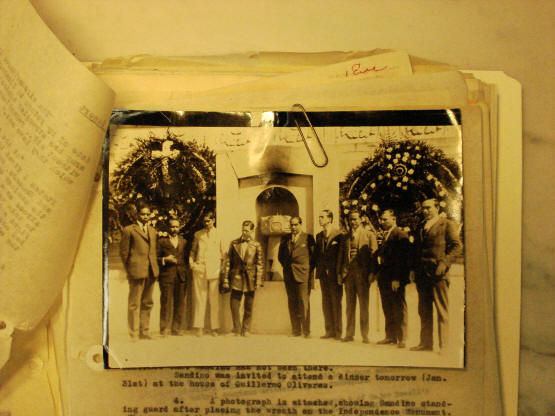 Page
1 of 'Fat
File' on 'Sandino Situation' by US
Military Intelligence Division, 1928-33 Page
1 of 'Fat
File' on 'Sandino Situation' by US
Military Intelligence Division, 1928-33
Tucked inside the
masses of mostly irrelevant information
(for my purposes)
that comprises Record Group 165, Entry 77,
Military Intelligence Division, Nicaragua,
1922-1944 in the US National Archives in College
Park, MD, are
three fat file folders in Box 2653
titled
“Sandino Situation” that
include detailed reports from all over the map —
Costa Rica, Mexico, Honduras, Texas, Panama,
Chile, Argentina, Venezuela — including spy
reports of Sandino’s activities in Mexico. This
Fat File on
the Sandino Situation
(as I call it) helps to illuminate at least some
of the hidden
contours of the international
dimensions of Sandino’s struggle as these were
tracked by the still-nascent US intelligence
apparatus. This material has never
been microfilmed or published anywhere else.
In two
Pleet-funded trips to
College Park in January & March 2011, I
digitally photographed these three fat files in
their entirety & original sequence.
Here the contents of these files are presented
in 12 Web
pages, in
593 digital
images (JPEG files) comprising
486
individual documents. Yes,
that’s right: Doc 95 is really 486
documents, more or less (it depends on how
one defines “a document,” an issue explored
further on
PAGE 2
) in 593 JPEG files. It’s a
mass of material. This
EXCEL SPREADSHEET list all
documents in this collection in their original
sequence; the second tab organizes them
chronologically.
Many thanks
to Pleet-funded Lebanon Valley College Pleet
Grant-funded student researcher Nicholas J.
Quadrini, who digitally prepared these JPEG
images and identified some of the documents'
titles & keywords, and to LVC Arnold
Grant-funded student researchers Dan Schramm for
compiling the spreadsheet, and Laura Cramer,
Katheryn O'Hara, and Erica L. Laufer for
their precise transcriptions. Appreciation
is also extended to Mr. Brandon Ray, Summa
Cum Laude college graduate from Ashford
University in Iowa (with a B.A. in History and a
minor in Political Science) for his meticulous
transcriptions.
|
|
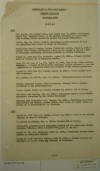
|
1. ca. Sept. 15, 1931.
"Mexican Aid to Nicaraguan
Rebels - Sandino Activities
Beginning 1926. Index," p.
1.
"1926
¶ D.J. report, San Antonio
Texas, week ending June 26,
1926.--Officially denied that
President Galles or the Mexican
Government is cooperating with
or aiding
Liberal revolution
against Nicaraguan Government.
¶ O.N.I., July 22,
1926.--Details concerning
reported shipment of arms and
ammunition from Mexico to rebels
in Nicaragua. ¶
Translation from La Prensa,
Managua (Government paper),
August 6, 1926.-- Excerpt from
alleged confidential letter by
Dr. Sacasa to Liberal leader in
Nicaragua, concerning assistance
rendered by Mexican Goverment.
¶ Report No. 1925 from
M/A, Guatemala, August 27,
1926.-- Alleged reported proof
of Mexican aid to Nicaraguan
rebels. ¶ Memo. for
the A.C. of S., G--2, August 30,
1926, from Chief, Latin American
Section.-- A resume of
information concerning alleged
shipment of arms and ammunition
to Nicaraguan rebels by
officials of the Mexican
government. ¶ Report
No. 1069 from M/A, Mexico,
August 31, 1926.-- Status of
relations with Nicaragua.
¶ M/A, Mexico, No. 175-26,
Sept. 24, 1926--
Mexican-Nicaraguan Relations.
¶ Monthly Political
Report, State Department,
October, 1926.-- Mexican
assistance to the
revolutionaries. ¶ O.N.I
report, Serial No. 230-26,
November 12, 1926.-- Aid to
Sacasa. ¶ 8th Corps
Area Summary, Dec. 15, 1926.--
Nicaraguan Liberal revolutionary
government recognized by the
Mexican Goverment ¶
Clipping from Washington Post,
December 28, 1926.-- Concerning
statements from Russian and
Mexican sources denying that
Mexico or soviet Russia is
giving aid to revolutionists in
Nicaragua. ¶ 1927 ¶ Report No. 1353
from M/A, Mexico, January 28,
1927.-- Facts as to original
shipment of arms to
Nicaragua. ¶ Department of
Justice, Feb. 1, 1927.-- Mexican
aid to Sacasa. ¶ Information
prepared in G-2 concerning
Mexican aid for Nicaraguan
revolutionists, February, 1927:
G-2/2657-P-241, pages 15 and
19. ¶ Report No. 22, M/A,
Nicaragua, March 19, 1927.--
Concerning Mexican interference
in Nicaraguan affairs. ¶ Report
No. 1451 from M/A, Mexico, March
22, 1927.-- Alleged purchase of
munitions of war by Mexico for
shipment to Nicaragua.
|
|
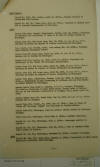
|
2. ca. Sept. 15, 1931.
"Mexican Aid to Nicaraguan
Rebels - Sandino Activities
Beginning 1926. Index," p.
2.
"1927 (cont.) ¶ Report No. 1496,
NMA, Mexico, April 26, 1927.--
Alleged shipment of ammunition
from Germany. ¶ Report No. 85,
M/A, Costa Rica, July 13,
1927.-- Reaction of Central
America to American intervention
in Nicaragua. ¶ 1928 ¶ Report
from Amer. Consul, Guadalajara,
Mexico, Jan. 29, 1928.--
Formation of committee for
collection of funds to be used
in aiding Sandino in Nicaragua.
¶ Letter from G-2, 8th Corps
Area, Fen. 16, 1928, to A.C. of
S., G-2.-- Activity in Mexico in
support of Sandino revolution in
Nicaragua. ¶ D.J. report, San
Antonio, Texas, week ending Feb.
18, 1928.-- Mexicans again
helping Nicaraguan rebels. ¶
Letter from 8th Corps Area,
March 20, 1928, to A.C. of S.,
G-2.-- Mexican aid to Sandino in
Nicaragua. ¶ Report from M/A,
Mexico, No. 2995, March 23,
1928.-- Formation and Activities
of the “Hands Off Nicaragua
Association”. ¶ Letter from G-2,
8th Corps Area, March 23, 1928,
to A.C. of S., G-2.-- Activity
in Mexico in support of Sacasa
revolution in Nicaragua. ¶
Letter from G-2, 8th Corps Area,
March 28, 1928, to A.C. of S.,
G-2.-- Activity in Mexico in
support of Sacasa revolution in
Nicaragua. ¶ Letter from Amer.
Ambassador, Mexico, April 11,
1928, to Secretary of State.--
Concerning alleged forwarding of
officers and men from Mexico to
assist Sandino in Nicaragua. ¶
Secret letter from Major H.
Schmidt, U.S.M.C., Managua,
Nicaragua (no date).-- Statement
of Julio Cesar Rivas, former
agent of Sandino and now in the
National Penitentiary in
Managua, Nic., given April 21,
1928. ¶ Secret letter from M/A,
Costa Rica, May 14, 1928, to
A.C., of S., G-2.-- Mexican Aid
to Sandino.¶Report from M/A,
Mexico, No. 2072, May 14,
1928.-- Copy of Organ of “Hands
off Nicaragua League” and
clippings re Sandino rebels. ¶
Report from M/A, Micaragua, June
18, 1928.-- Entire aspect in
Nicaragua changed. ¶ Cable from
M/A, Nicaragua, dated July 5,
1928.-- Sandino situation. ¶
Report No. 31, M/A, Nicaragua,
July 9, 1928.-- Messenger
service to Turcios. ¶ Report No,
34, M/A, Nicaragua, July 18,
1928.-- Line of communication
from Sandino to Turcios. ¶
Report No. 68, M/A, Nicaragua,
November 17, 1928.-- Sandino
situation. ¶ 1929 ¶ Report No.
410, M/A, Costa Rica, January 4,
1929.-- Resumption of Costa
Rican diplomatic relations with
Nicaragua."
|
|
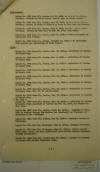
|
3. ca. Sept. 15, 1931.
"Mexican Aid to Nicaraguan
Rebels - Sandino Activities
Beginning 1926. Index," p.
3.
"1929 (cont.) ¶ Letter No. 2398
from M/A, Mexico, May 17, 1929,
to A.C. of S., G-2.-- Sandino,-
Attitude of Julio Sierra,
Assist. Sec. of State, toward ¶
Letter No. 2469 from M/A,
Mexico, June 28, 1929, to A.C.
of S., G-2.-- Sandino,-Arrival
in State of Chiapas en route to
Vera Cruz for Yucatan. ¶ Letter
No. 2477 from M/A, Mexico, July
5, 1929, to A.C. of S.,
G-2.--Sandino,- Arrival in Vera
Cruz on June 28, 1929, with
staff. ¶ Report No. 2489 from
M/A, Mexico, July 12, 1929.--
Press propaganda in connection
with Sandino. ¶ Letter No. 2667
from M/A, Mexico, December 10,
1929.-- No indication that
Sandino was endeavoring to leave
Mexico. ¶ 1930 ¶ Report No. 2735
from M/A, Mexico, Jan. 31,
1930.-- Activities of Sandino in
Mexico City. ¶ Report No. 2736
from M/A, Mexico, Feb. 3,
1930.-- Activities of Sandino in
Mexico City. ¶ Report No. 2743
from M/A, Mexico, Feb. 6,
1930.-- Activities of Sandino in
Mexico City. ¶ Report No. 2755
from M/A, Mexico, Feb. 11,
1930.-- Activities of Sandino in
Mexico City. ¶ Report No. 2759
from M/A, Mexico, Fen. 13,
1930.-- Activities of Sandino in
Mexico City. ¶ Report No. 2765
from M/A, Mexico, Fen. 18,
1930.-- Activities of Sandino in
Mexico City. ¶ Report No. 2771
from M/A, Mexico, Feb. 19,
1930.-- Activities of Sandino in
Mexico City, Feb. 16, 17 and 18,
1930. ¶ Report No. 2776 from
M/A, Mexico, Feb. 21, 1930.--
Activities of Sandino in Mexico
City. ¶ See page 4. ¶ Report No.
2783 from M/A, Mexico, Feb. 28,
1930.-- Activities of Sandino in
Mexico City; departure of
Sandino on Feb. 22, 1930, for
Merida via Vera Cruz. ¶ Report
No 2797 from M/A, Mexico, March
10, 1930.-- Payments of funds
made to Sandino through the
Mexican War Department and
Treasury, by direction of the
President. ¶ Report No. 2911
from M/A, Mexico, May 23,
1930.-- Sandino’s return to
Nicaragua. ¶ Report No. 744 from
M/A, Nicaragua, June 4, 1930.--
Sandino’s situation. ¶ Report
No. 768 from M/A, Nicaragua,
June 18, 1930.-- Recent reports
from bandit areas; has been
ascertained that Sandino entered
Nicaragua through Totecasinte. ¶
Report No. 2948 from M/A, Mexico
June 17, 1930.-- Sandino has
severed relations with Mexican
Communist Party."
|
|
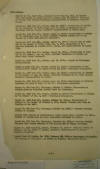
|
4. ca. Sept. 15, 1931.
"Mexican Aid to Nicaraguan
Rebels - Sandino Activities
Beginning 1926. Index," p.
4.
"1930
(cont.) ¶ Comment by M/A, Costa
Rica, received in G-2 July 30,
1930, in connection with report
No. 2949, from M/A, Mexico, June
17, 1930.-- Relations of Sandino
with Esteban Pavletich,
representative of Communist
Party in Mexico. ¶ Report No.
2963 from M/A, Mexico, June 30,
1930.-- Translation of article
in “El Excelsior” of Mexico
City, June 26, 1930, purporting
to be an interview with Dr.
Zepeda, Sandino’s representative
in Mexico City. ¶ Report No.
3031 from M/A, Mexico, August 8,
1930.-- Translation of article
in “El Excelsior”, Aug. 5, 1930,
entitled “Sandino Relates how he
was Wounded by a Bomb from
American Airplanes”. ¶ Report
No. 3037 from M/A, Mexico,
August 12, 1930.-- Translation
of article in “La Prensa” of
Mexico City, Aug. 9, 1930,
purporting to be a bulletin
furnished by Sandino to Dr.
Zepeda, his representative in
Mexico City. ¶ Report N. 3045
from M/A, Mexico, August 15,
1930.-- Translation of article
in “La Prensa”, Aug. 14, 1930,
entitled “Relatives of Sandino
and other Rebel Chiefs
Tortured”. ¶ Report No. 3049
from M/A, Mexico, Aug. 19,
1930.-- Report on Nicaraguan
revolutionists. ¶ Report No.
3054 from M/A, Mexico, August
22, 1930.-- Translation of two
articles in “La Prensa” of
August 16 and 18, 1930 -
Nicaraguan propaganda. ¶ Report
No. 3077 from M/A, Mexico, Sept.
12, 1930.-- Translation of
article in “La Prensa” of Aug.
30, 1930.-- Bulletin furnished
by Dr. Pedro Zepeda, Sandino’s
representative in Mexico. ¶
Report No. 3081 from M/A,
Mexico, Sept. 24, 1930.--
Translation of articles
appearing in press of Sept. 15
and 21 - Nicaraguan propaganda.
¶ Report No. 909 from M/A,
Nicaragua, October 2, 1930.--
Information on Sandino given by
Feliciano Centeno after his
surrender. ¶ Report No. 3097
from M/A, Mexico, October 4,
1930.-- Translation of article
in “La Prensa” of Oct. 2, 1930 -
Nicaraguan propaganda. ¶ Report
No. 3108 from M/A, Mexico,
October 10, 1930.-- Translation
of article in “La Prensa” of
October 8, 1930, headed “Sandino
will keep on Fighting to the
End”. ¶ Report No. 960 from M/A,
Nicaragua, October 29, 1930.--
Socrates Sandino, brother of
Sandino. ¶ Excerpt from Summary
of Intelligence, Panama Canal
Dept., October 30, 1930.--
Brother of Sandino held by local
quarantine officials at Balboa.
¶ Report No. 969 from M/A,
Nicaragua, November 10, 1930.--
Socrates Sandino deported from
Panama November 8 with
destination La Union, Salvador.
¶ Report No. 3154 from M/A,
Mexico, November 27, 1930.--
“General” Rafael deo Nogales,
and Dr. Pedro J. Zepeda,
Sandino’s representative in
Mexico - Sandino propaganda. ¶
Report From M/A Mexico, No.
2783, February 24, 1930.--
Nicaraguan propaganda - “The
Sacking of Nicaragua”, by Rafael
de Nogales, Venezuelan author."
|
|
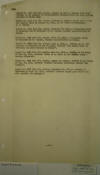
|
5. ca. Sept. 15, 1931.
"Mexican Aid to Nicaraguan Rebels
- Sandino Activities Beginning
1926. Index," p. 5.
“1931 ¶ Report No. 3190 from
M/A, Mexico, January 2, 1931.--
Message sent from Sandino to the
Congress of Latin-American
Students which has been holding
sessions in Mexico City. ¶
Report No. 3226 from M/A,
Mexico, February 3, 1931.--
Report sent to the Los Angeles
Times on January 29, 1921, by
its staff correspondent, C. W.
Martin. ¶ Report No. 3242 from
M/A, Mexico, February 17,
1931.-- Propaganda given to
Excelsior and El Universal by
Dr. Zepeda, Sandino
representative in Mexico. ¶
Report N0. 3266 from M/A,
Mexico, March 13, 1931.--
Propaganda given to Excelsior by
Dr. Zepeda, Sandino
representative in Mexico. ¶
Report No. 3381 from M/A,
Mexico, June 2, 1931.-- Article
on Dr. Pio Palacios in Excelsior
of May 29, 1931, entitled “The
Health Envoy to Nicaragua has
just Returned to Mexico”. ¶
Report No. 3391 from M/A,
Mexico, June 16, 1931.-- Article
in Excelsior of June 13, 1931,
entitled “There is no Split in
the Sandino Group - Another
Offensive”. ¶ Report No. 3506
from M/A, Mexico, August 25,
1931.-- Article in La Prensa of
Aug. 25, 1931, entitled “Sandino
continues victorious against the
Yankees”. ¶ Report No. 3537 from
M/A, Mexico, September 15,
1931.-- Article in Excelsior of
Sept. 12, 1931, entitled
“Sandino enjoys good health and
will continue the struggle.”
|
|
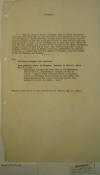
|
6. May 16, 1930.
Military Attaché,
Mexico to Col. Ford; incl.
telegram from American Consul in
Progreso, Yucatán
to US Embassy in Mexico City.
"NICARAGUA. ¶ Upon
my return I found a telegram
from the State Department, which
has doubtless come to your
attention, with reference to the
departure of Sandino.
There have been so many rumors
and contradictory reports in
regard to him that I thought it
best to send Captain Cummings
down by plane at once. I
had intended him to take this
trip within the next few days
anyhow, and in view of the
concern of the State Department,
thought it best to send him at
once. His instructions were to
go by airplane from Vera Cruz to
Yucatan directly, investigate
the Sandino situation in
cooperation with the Consul at
Progreso, and then return by way
of Campeche and Tabasco. ¶
P.S. ¶ Following
telegram just received: ¶
From American Consul at
Progreso, Yucatan: To Embassy,
dated May 16, 8 a.m. ¶
“Following telegram has been
sent to the Department May 15 10
A.M Department’s telegram of May
14 6 P.M. Today’s press
contains report of Sandino’s
return to Nicaragua with
notation to the effect that
investigation proves that he has
been absent from Merida for
about one month. Lane.” ¶
(Excerpt from letter to Col.
Ford from M/A, Mexico, May 16.
1930.)"
|
|
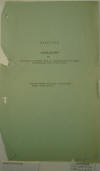
|
7. March 1930.
"Sandino Situation and
Assistance he received from the
Anti-Imperialistic League from
February 1928 to March 1930."
"NICARAGUA ¶ SANDINO
SITUATION ¶ and
¶ Assistance he received
from the Anti-Imperialistic
League from February 1928 to
March 1930. ¶
(Current Sandino Situation in
Nicaraguan Digest under
3020-d.)" [Cover page for all documents to
follow, up to March 1930.]
|
|
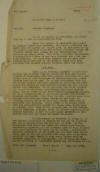
|
8.
February 13, 1928. G-2
Report on Sandino Campaign,
Major Fred T. Cruse, Military
Attaché, Tegucigalpa, p. 1.
"So far as Sandino is concerned,
the situation up to date is
approximately this: ¶ After the
capture of Sandino’s stronghold
at Chipote (exact date unknown),
his force apparently was split
into two parts; the larger part,
in fact practically his entire
remaining force was driven
northwest towards the Honduran
border near Jalapa and has
disintegrated and practically
disappeared. This force
contained Nicaraguans, a
considerable number of men from
Salvador and a few men from
Honduras. At least four hundred
men who were with Sandino up to
the time of the Chipote fight
have been accounted for passing
through Honduras since the
fight. ¶ Arms. ¶ There is no
evidence anywhere to show that
Sandino has received arms or
ammunition from any source
outside of Nicaragua, with the
possible exception of a few
rifles carried into Nicaragua by
Salvadorians who joined Sandino
some months ago. It is said
everywhere that all the rifles
Sandino has were already in
Nicaragua and were simply not
turned in when General Moncada
and the Liberal forces were
disarmed. It is reported, and in
my opinion the report is
definite, that Sandino has three
machine guns. One of these he
got from General Concepción
Peralta, who is a Honduran and
is in revolt against the present
Honduras government. The other
two are machine guns which
Sandino took from government
forces in the fight at Jinotega
shortly after he declared
himself unwilling to surrender
with Moncada. There seems to be
little doubt that the
anti-aircraft mounts for these
guns, first used at Quilali,
were made in the machine shop of
the Zurcher mine in Yuscaran,
probably under the direct
supervision of Sandino himself.
A fact not previously stressed
is that Sandino has been for
years an expert mechanic. ¶ The
government of Honduras is doing
all it can against operations by
Sandino or his men in Honduras,
but the situation along the
frontier is this: on the
Nicaraguan side there are towns
and fairly good trails.
Immediately opposite, on the
Honduras side is wild country
with practically no villages and
no trails. Patrols can maintain
themselves in the mountains not
more than two or three days at
the end of which time they have
to go back, probably two days’
march to some small center such
as: Paraiso, Zapotillo or
Pedregalito, all of which are
tiny places affording in
themselves hardly any facilities
at all. . . . "
|
|
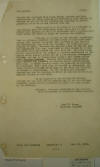
|
9.
February 13, 1928. G-2
Report on Sandino Campaign,
Major Fred T. Cruse, Military
Attaché, Tegucigalpa, p. 2.
"
. . . Reports are constant from
these border patrols and from
practically all other sources of
information that Sandino is
anxious to get out of the
country and actually is either
preparing to do so or has
already done so. ¶ These reports
do not seem to be confirmed by
information from the Nicaraguan
side; which are to the effect
that Sandino is still in
Nicaragua with a considerable
armed force and shows no signs
of leaving the country. ¶
Finally, it cannot be too
strongly emphasized that no
evidence whatever has been found
on this side indicating that
Sandino receives, has received
or can receive any substantial
help from the outside. He sends
men constantly to Danli,
Yuscaran and smaller towns to
buy all pistol ammunition they
can, even four or five rounds at
a time purchased from any person
who will sell it. The only thing
so far discovered in the nature
of outside assistance is the
purely moral support given him
by a few radical newspapers
editors, the one in Tegucigalpa
being a well known writer named
Froilan Turcios. Turcios
undoubtedly communicates with
Sandino and purports to receive
daily communications from him.
As these reports could not
possibly be received by
telegraph, they could only be
brought by messenger, who would
require at least seven days to
get from the vicinity of Jalapa
to Tegucigalpa. To all intents
and purposes Sandino now has the
marines in front of him and
practically unknown country at
his back. ¶ In my opinion he can
accomplish nothing further and
can only end by endeavoring to
get out through Honduras, which
he will probably do after the
next attack by the marines."
|
|
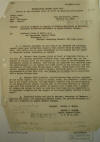
|
10.
February 16, 1928. Secret
G-2 Report on Activity in Mexico
in Support of Sandino Revolution
in Nicaragua, Candidate of
Mexican Goverment to Oppose
General Obregon, Major Robert J.
Halpin, Fort Sam Houston, Texas,
to Assistant Chief of Staff,
G-2, War Dept., Washington D.C.
"1. A reliable informant of this
office has rendered the
following report, based upon
information received from
sources which he deems reliable.
This office has no other
information on the subject and
the report is submitted without
evaluation or comment. ¶ a.
General José Alvarez, Chief of
Staff of President Calles, is
the head of a society organized
in Mexico City, four months ago,
for the purpose of raising funds
for the support of the cause of
the Nicaraguan revolutionists
headed by Sandino. The society
has organized and conducted
popular entertainments in the
capital and other cities in the
vicinity, and has succeeded in
raising about 25,000 pesos a
month. These funds have been
forwarded, through the Mexican
Consul General, Arturo M. Elias,
to Sandino’s representative in
New York City, one Salomon de la
Selva, who is associated with a
Doctor Timoteo Baca. ¶ b.
General Pablo Gonzales, retired
Mexican Army officer, opponent
of the Calles regime, now living
in Laredo, Texas, has received a
letter from one of his former
officers, now imprisoned in
Mexico City for participation in
the Gomes-Serrano revolt,
stating that he and other
officers in confinement have
been approached by agents of
General José Alvarez with a
promise of release and pardon in
April on condition that they
join an expedition to be
organized in Mexico for the
purpose of assisting General
Sandino in Nicaragua. ¶ c.
President Calles and Luis N.
Morones, Secretary of Commerce,
Industry and Labor, are
supporting General Amaro, the
present Secretary of War, as a
candidate to oppose General
Obregon ¶ (Signed) Robert J.
Halpin"
|
|
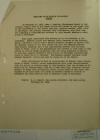
|
11.
February 18, 1928. D. J.
Report on Mexicans Again Helping
Nicaraguan Rebels, from San
Antonio District, Texas.
"On February 15, 1928, Adam Z.
Moralez [Adán Z. Morales],
Nicaraguan Consul in San
Antonio, Texas, came to the
Bureau office and stated to this
Agent that he had information to
the effect that Gen. Agustin
Sandino, rebel chief in
Nicaragua, was getting financial
help from Mexico; also that they
are preparing to send Mexican
soldiers to join General
Sandino’s rebel group in
Nicaragua. ¶ This agent
questioned Adam Moralez as to
the veracity of this informant.
Morales stated that General
Pablo Gonzales of San Antonio,
Texas, received a letter from a
Mexican General prisoner in
Mexico City. Mr. Moralez stated
he saw this letter and that this
Mexican General told General
Gonzales that a man representing
General Jose Alvarez, Chief of
Staff, came to the penitentiary
and offered to free them if they
agreed to join an armed
expedition that was being
organized in Mexico to join Gen.
Agustin Sandino’s rebel forces
in Nicaragua sometime next April
to fight the U. S. Marines. The
Mexican General prisoner asked
General Gonzales’ advice and
what he should do in the matter.
¶ Other information is that by
instructions of General Jose
Alvarez, Chief of Staff, certain
social organizations have given
entertainments with the object
of raising money to help
Sandino; that one Solomon de la
Silva and Dr. Timoteo Baca, both
now in New York City, received
certain amounts of money from
the Mexican Consul Arturo Elias
of New York; that Solomon de la
Silva [Salomón de la Selva] sent
this money by General Sandino’s
brother to Guatemala and from
there by land to Sandino’s camp
in Nicaragua."
|
|
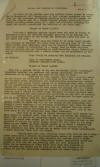
|
12. March 12,
1928. G-2 Report on Marine
Air Tactics in Nicaragua, Major
Fred T. Cruse, Military Attaché,
Tegucigalpa, p. 1.
"On March 3d the Marines sent
two Curtiss Falcon planes to
bring me to Managua. We left
Tegucigalpa at 9:00 A.M. and
proceeded via Amapala and the
volcanoes, to Managua, arriving
11:30 A.M. This report covers
two flights made in a Vought
Corsair pursuit plane, with
Major Rowell piloting. Before
going up I spent one afternoon
learning the panel and pistol
signals, and the handling of the
Lewis gun. ¶ Flight of March 7,
1928. ¶ This was strictly
routine flight over the zone of
action in Matagalpa, Esteli and
Leon. The original plan was to
go through the Yali pass, just
north of San Rafael del Norte,
and scout the area to the north
and east. ¶ The Yali pass was
found to be under heavy clouds
and although we followed the
cloud line all the way west to
the Honduran border near
Somotillo there was no break. We
therefore returned east and
landed at Esteli. This is a
supply base to which supplies
come by ox-cart and are
forwarded by pack-train. The
supply service is now so far
established that a mobile column
can be maintained in the field.
¶ From Esteli we returned via
Trinidad and Granada to Managua.
¶ Time in air—Three hours. ¶
Distance covered—300 miles. ¶
Flight of March 9, 1928. ¶ This
was a special flight to try and
definitely locate Sandino,
information received the
previous day having definitely
located him somewhere in an area
north and east of the town of
Yali. ¶ Took off at 8:45 A.M.
and flew almost directly north
to San Rafael de Norte. For the
next hour we flew over small
towns in the vicinity where
detachments are stationed. The
co-operation between the planes
and ground troops seemed to be
excellent. Most towns displayed
the panel TX - nothing to
report. In a few there was an MM
panel, which called for a
message pickup. In such cases
the message was on a string
stretched between two poles, and
we lowered a weighted hook and
picked them up from a height of
about sixty feet. Most of these
messages were late information,
but some called for assistance
of one sort of another. ¶
Answers were given by dropped
messages, and in some cases by
red or green flares from the
Very pistol. ¶ At San Juan
Telpaneca, which is slightly
southeast from Telpaneca itself
we found the C.P. of the column
in the field. They displayed a
panel reading:- “I am marching
to-morrow.” Just then the two
contact planes from Ocotal came
over and we signaled them and
again started out, following the
mountain range along the south
side of the Coco River as far as
Insina, and then swung
southeast. ¶ From then on we
were in bandit country. This
fact became evident almost as
once. Up until then the towns
and houses had seemed, at least
from the air, to be perfectly
normal and at ease. It was
different now. As we passed over
houses one of two things
happened:-either no one appeared
at all, or the whole family
rushed out and stood in the
open. Where no one showed up
major Rowell opened up to about
a hundred and forty miles an
hour and dived down for a look.
The country was all steep
mountains and deep valleys, so
by doing this we could actually,
for a short time, see right into
the houses. ¶ Finally, over the
first mountain range from Yali
we saw a fair-sized house with a
totally disproportionate amount
of laundry hung out to dry. We
flew round on one wing watching
and spotted about a dozen
saddled horses tied near the
house. Major Rowell immediately
dived and opened up with the bow
gun, shooting into the dust
alongside the [ . . . ] There
was no reaction, as there would
have been with innocent p [ . .
. ] the location was marked and
we went on. We did not attack,
as it [ . . . ] policy to use
two planes, one attacking and
the other trying to [ . . . ] .
. ."
|
|
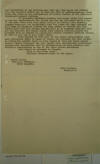
|
13. March 12,
1928. G-2 Report on Marine
Air Tactics in Nicaragua, Major
Fred T. Cruse, Military Attaché,
Tegucigalpa, p. 2.
"
. . . and concentrate on any
machine-guns that may open up.
On our present trip the constant
effort was to draw the fire of
machine-guns, as these label the
place as the headquarters of
either Sandino or his principal
lieutenant, General Montoya. ¶
We proceeded northeast, looking
into every house that seemed in
any way suspicious. In two
places men ran out and waved
white flags. It has been found
that this means Sandino or
Montoya have recently stopped
there, and the inhabitants fear
the plane has been informed and
will bomb the place. We located
two more groups of bandits and
then turned north and flew
around Chipote. This is an
enormous mountain mass and the
trenches and burned houses were
clearly visible. Chipote was
attacked late in January by
planes, and Sandino suffered
terrible losses. In fact he has
had no real force since. ¶ From
Chipote we flew west to San
Albino mine, working some more
garrisoned towns by means of
panels and messages and then
landed at Ocotal. The country
there is like around El Paso and
other border towns. A Fokker
transport had just landed with
supplies. Our information
checked with information sent by
informants, so we were probably
over Sandino’s headquarters in
one of the three places
mentioned. ¶ From Ocotal we
returned to Managua. ¶ Time in
air--Four hours. ¶ Distance
covered--Close to 500 miles."
|
|
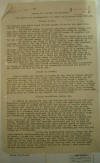
|
14. March 16,
1928. Supplementary G-2
Report on Marine Air Tactics in
Nicaragua, Major Fred T. Cruse,
Military Attaché, Tegucigalpa,
p. 1.
"Planes in Use. ¶ The Marines
have three types of land planes
in use in the operations against
the bandits. ¶ Tri-motored
Fokker transports maintain a
regular supply service from
Managua to Ocotal, Jicaro and
Jalapa, and bring in wounded
from these points. They carry
eighteen hundred pounds of
supplies each trip and usually
make two trips each every day. ¶
Curtiss Falcon observation
planes of the latest type are
used for all other purposes
except attack or scouting in the
high mountains. ¶ An entirely
new class of ship, a pursuit
plane capable of carrying two
men, is the one relied on for
the difficult and dangerous work
of scouting and fighting in the
present mountainous area. ¶
These Vought Corsairs are
tremendously effective. With the
throttle less than half open
they cruise at a speed of a
hundred miles an hour, and for
work under fire they travel
readily at 140 or 150. They
carry a bow gun, located on top
of the upper wing and fired by a
lever on the control stick and a
Lewis gun mounted on the edge of
the rear cockpit, and eight
bombs under the wings. Owing to
shortage of bombs planes have
not been dropping unused ones
before landing, but land with
them all the time, without any
accidents so far. ¶ These planes
can circle standing up on one
wing indefinitely giving an
excellent view of the ground,
and enabling the gunner to get
perfect aim with the Lewis gun.
¶ Attack of Houses. ¶ Where
bandits are located in houses,
as they nearly always are, the
procedure is something like
this:-- the plane dives down,
using the bow gun, then swings
over on one wing, climbs fast
and drops a bomb. By fast work
the ship can then turn over on
the right wing in time to see
the bomb hit. The bandits have
learned how to tell when a bomb
is dropped and run for cover
before it hits. The plane,
circling on one wing, is then in
perfect position to attack them
with the Lewis gun. A group
attacked in this way is usually
entirely wiped out. In the
meantime the second plane
circles or dives, on the lookout
for machine-guns. ¶ Flying
conditions always bad. ¶ It
should be emphasized that the
Marines are facing the most
continuously dangerous flying
conditions I have ever seen.
There are two mountain ranges to
cross before even the fringe of
hostile territory is reached and
usually two of three more before
going into action. The winds and
cross currents over these are
always bad. Drops of two hundred
to a thousand feet are an
everyday occurrence and on the
two flights in the Corsair
mentioned in my No.18 we were
repeatedly dropped absolutely
sideways and down without the
slightest warning. ¶ In the area
between Chipote and Yali, where
Sandino was last located, it is
necessary to fly low in the
valleys in order to really
observe, and only the Corsairs
could ever get out of some of
the air conditions encountered.
With their reserve speed of more
than forty miles an hour for
emergencies, they have so far
been able to avoid a crash, when
suddenly dropped or swept
sideways, but they may not
always be so fortunate. ¶ At his
own headquarters Sandino always
has two anti-aircraft
machine-guns, one on each side
of the valley, and there is
hardly a plane that hasn’t
bullet holes through the wings.
Several times lately low-flying
planes have been fired at with
sky-rockets, probably in the
hope of setting the wings afire.
These sky-rockets are made of
nitrates and charcoal obtained
locally. They are usually seen
as soon as they leave the ground
and are of course a dead
give-away of the location of the
bandits. . . . "
|
|
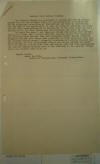
|
15. March 16,
1928. Supplementary G-2
Report on Marine Air Tactics in
Nicaragua, Major Fred T. Cruse,
Military Attaché, Tegucigalpa,
p. 2.
"
. . . Contact with Moving
Columns. ¶ Two Corsair planes
are stationed at Ocotal, and act
as contact planes for the two
columns which are now closing in
on Sandino. One of the principal
objectives of the Marines has
been to deprive him and his men
of the opportunity to rest in
towns or villages and this has
now been accomplished. He is
restricted to the area south of
the headwaters of the Coco
River, east of Telpaneca and
north of Yali. ¶ On March 9th,
when I saw them, one column was
moving east through Insina, the
other east through Yali. The
contact planes were maintaining
communication between them and
attacking bandit groups wherever
found. The planes have never
been permitted to bomb towns,
and this has let Sandino escape
several times. For instance, on
February 4th, the day Beals
claims to have interviewed him,
he was in San Rafael del Norte
with 150 men. The planes knew
this and stayed over the town
practically all day, but beyond
getting word of his location to
the nearest troops there was
nothing they could do."
|
|
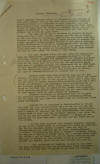
|
16. April 1, 1928.
G-2 Report on Sandino Situation,
Major Fred T. Cruse, Military
Attaché, Tegucigalpa, p. 1.
"When I reached Honduras early
in February it was evident at
once that Sandino and his men
were using Honduran territory
opposite Jalapa as a back-yard
or rest area. They came and went
about as they pleased, not
exactly openly, but still
freely. Men of their type are
willing to undergo almost any
sort of danger or hardship if
they can periodically get into
some village for a rest and good
time. ¶ The Minister of War of
Honduras is General Martinez
Funes, who when I left Central
America in 1922 was in revolt in
the very area in questions. I
went to him and after some
discussion he agreed to send
Colonel Ramon Nolasco to command
the patrol opposite Jalapa.
Colonel Nolasco is not only a
good, reliable soldier, but a
fanatical Conservative—that is,
give him one Liberal and one
machete and he would know
exactly what to do. He took over
the patrol on Feb. 3d, since
which date Sandino and his men
have given the region a wide
berth. ¶ The next helpful thing
was word from the Marines to
look out for General J. Antonio
Sequeira, supposed to be the
messenger between Ferrera and
Sandino. He was located and
picked up here the same day, and
while he never admitted anything
else he did state that he was
the man who had guided Beals
from here to Sandino. Although
the Government has no real right
to hold him, the Minister
persuaded them to do so. He was
held for two weeks, which should
have been sufficient to disrupt
his line of communication, and
we believe that it was. ¶
Sandino would have been finished
long ago had the Marines not
lost their heads after the
Quilali fight and broadcast the
statement that he had appeared
there with a real army and all
sorts of modern weapons. That,
naturally; made him a real
object of admiration and
encouraged him tremendously, but
it was entirely untrue. The
whole thing turns out to have
been based on the fact that he
fired on the planes which
anti-aircraft machine-guns,
which were nothing but his same
three guns on some mounts which
he made himself in Yuscaran. ¶
Evidence continues to accumulate
that he had, with the possible
exception of some smuggled
cartridges, nothing but the same
old guns that are buried near
the frontiers after every
revolution. ¶ Sandino has no
prestige in Honduras. This is
due to the fact that the
Conservatives have no use for
him and the Liberals see that he
is actually damaging their
cause. To-day, when a couple of
thousand men were gather around
the Comandancia here to draw
lots for military service, a man
threw his hat in the air and
yelled “Viva Sandino!” A couple
of men called out “We don’t know
him.” And that was all there was
to the affair. ¶ It has been
supposed that Sandino received
supplies by way of the Patuca
River in Honduras. This river is
navigable for the big dug-outs
called “pitpans” from the Gulf
to Totecasinte, on the northern
tip of the Nueva Segovia.
However, a captain B.C. Brown,
who was aide to General W.H.
Gordon during the war, has a
string of lumber camps for a
hundred miles along the Patuca.
I got in touch with him at
Puerto Castilla on Jan. 27th,
and he assured me that nothing
could go up the river without
his knowing about it and that
nothing had gone up. ¶ The
Government of Honduras is much
on the alert for arms shipments,
as they are dangerously short
themselves and would be more
that delighted to get some for
nothing."
|
|
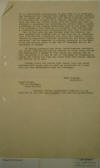
|
17. April 1, 1928.
G-2 Report on Sandino Situation,
Major Fred T. Cruse, Military
Attaché, Tegucigalpa, p. 2.
" . . . It is continually
reported, no so much here as in
Nicaragua and Guatemala that
Sandino will combine with
Liberal elements and if driven
out of Nicaragua will invade
Honduras, assisted by them. That
for a while was a serious plan,
but about ten days ago when the
Liberal Party held its
Convention here to nominate a
candidate for President, the
leaders held a secret conference
at the Pension Nuila, next door
to the hotel where I am staying.
At this meeting the Delegate
from Yuscaran, who is violently
Radical and anti-American made
this statement: ¶ That he had
been the man through whom the
liberals had been dealing with
Sandino: that he had been out of
communication with him for a
month, and the Party had dropped
Sandino because he repeatedly
violated instructions and broke
agreements: and that he amounted
to nothing anyway, as he had
only a few men and was going to
get out of Nicaragua and go to
Guatemala or Mexico. ¶ In
Mexico, Guatemala and other
Latin-American countries the
papers continually publish
stories of funds being raised
for Sandino. Not a dollar of
this money has reached him or
ever will. Even if it got as far
as Nicaragua or Honduras, his
agents are hardly the type who
would take even twenty dollars
and deliver it to him. ¶
Finally, there are hardly even
rumors here now about Sandino,
which means that he must be
restricted to a very small, or
very uninhabited area in
Nicaragua."
|
|
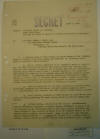
|
18. April 7, 1928.
Secret G-2 Report on Activity in
Mexico in Support of Sandino
Revolution in Nicaragua, Major
Robert J. Halpin, Fort Sam
Houston, Texas, p. 1.
"Subject: Political Issues and
Problems. ¶ Rebel Activities. ¶
Activity I Mexico in Support of
Sandino Revolution in Nicaragua.
¶ TO: Assistant Chief of Staff,
G-2, ¶ War Department General
Staff, ¶ Washington, D.C. ¶
(Through Commanding General, 8
th Corps Area) . ¶ 1. A reliable
agent of this office, an active
member of the “Catholic League
of Mexico” of El Paso, Texas,
has submitted the following
report which is forwarded
without comment: ¶ a. LUIS J.
BUSTOS, Treasurer of the
“Catholic League of Mexico”, and
the ‘real driving force behind
this organization’, has returned
from Rome and other European
cities, by way of Havana, New
York and Philadelphia, arriving
in El Paso on the 2d inst. A
general meeting of the League
has been called for today and it
is expected that many eminent
Catholic clergy-men will attend.
In connection with the mission
and activities of Señor Bustos,
it is said that the Catholic
Church in Spain, Hungary, and
Germany, (specifically on
Cologne) has commenced
propaganda of protest against
the Mexican Government’s abusive
treatment of Catholics in
Mexico. ¶ b. Arms and ammunition
for the Yaqui Indians and
Catholic rebels in Jalisco,
Purchased in California, through
a Mexican engineer, Señor - - -
TRASLOSHERORS, were recently
sent into Mexico, through
Tucson, Arizona. ¶ c. Yaqui
Indians, followers of Chief
Matus, are again on the
war-path, two groups, numbering
200 each, having joined the
Nayarit rebels from Sinaloa. ¶
d. CASTULO HERRERA, president of
the C.R.O.M (Confederacion
Regional de Obreros Mexicanos)
in Ciudad Juarez, Chuahua, is
known to be the Delegate General
of Pro-Sandino Clubs in Mexico,
now in Juarez: these two men
have been recently seen in
company with one - - - BRINGAS
is said to be a Mexican envoy to
Sandino, about to leave for
Central America from an American
port. Bringas . . . "
|
|
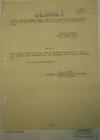
|
19. April 7, 1928.
Secret G-2 Report on Activity in
Mexico in Support of Sandino
Revolution in Nicaragua, Major
Robert J. Halpin, Fort Sam
Houston, Texas, p. 2.
"
. . . Was seen entering Laredo,
Texas, three or four days ago
and it is believed that his full
name can be secured from the
register at the international
bridge. ¶ Robert J. Halpin ¶
Major, General Staff, A. C. of
S., G-2. ¶ 1st Ind. ¶
HEADQUARTERS EIGHT CORPS AREA,
Fort Sam Houston, Texas, April
7, 1928. – To: Assistant Chief
of Staff, G-2 War Department
General Staff, Washington, D.C.
¶ For the Commanding General: ¶
GEO. L. HICKS, ¶ Colonel,
Adjutant General’s Department, ¶
Adjutant General."
|
|
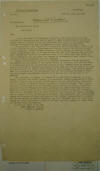
|
20. April 11,
1928. Confidential Report
on Mexican Aid to Sandino,
Dwight D. Morrow, Mexico, to
Secretary of State, Washington.
"The Honorable ¶ The Secretary
of State, ¶ Washington. ¶ Sir: ¶
I have the honor to acknowledge
receipt of the Department’s
strictly confidential
instruction No. 232 of April 3,
1928, transmitting for my
information copy of a report to
the War Department with regard
to the alleged forwarding of
officers and men from the Mexico
to assist Sandino in Nicaragua.
¶ As indicated in the
Department’s instruction under
reference, a copy of the report
received by the War Department
had already reached the Military
Attaché of this Embassy. Colonel
MacNab informs me that he places
no reliance in the report in
question; nor has he any
information that would confirm
the statement made therein that
officers and men were sent or
are being sent from Mexico to
assist Sandino or the statement
that Mexico is continuing to
sent forward fighting men in
small detachments for the
purpose. ¶ While, as previously
reported, the Mexican Government
has not concealed its belief
that the policy of the United
States in Nicaragua is a
mistaken one, I am persuaded
that its disagreement with us in
that respect finds no expression
in secret aid to Sandino and
others in Nicaragua who are now
engaged in hostilities against
the United States forces in that
country. The Mexican Government
is at present far too
preoccupied with its own
internal problems to make any
other course practicable, even
if it be assumed that it may
wish to aid Sandino. ¶ The
Department is aware of course,
of the existence in Mexico, as
elsewhere, including the United
States, of a so-called
“Comité-pro-Sandino”, which
collects funds openly in public
places and by private
solicitation, ostensibly for the
purpose of sending medical
supplies to Sandino’s forces.
This organization is understood
to be an entirely private one
and to have no connection
whatever with the Mexican
Government, although the latter
certainly refrains from any
interference with it. The
organization seems to enjoy the
particular favor of the
“Ucsaya”, which is also active
in this country but which
likewise, has no connection with
the Mexican Government. The
newspapers here occasionally
report the dispatch of funds
collected by the
“Comité-pro-Sandino” to Sandino
and the forwarding of medical
supplies, but it is believed
that the funds collected are
quite inadequate to recruit
officers and men, supply and
equip them, and forward them to
Nicaragua. ¶ I have the honor to
be, sir, ¶ Your obedient
servant, ¶ DWIGHT W. MORROW.
|
|
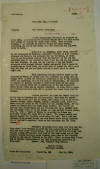
|
21. May 11, 1928.
G-2 Report on the Sandino
Situation, Major Fred T. Cruse,
Military Attaché,
Tegucigalpa.
"G-2 report. ¶ NICARAGUA (Pop. &
Social) ¶ Subject: ¶ The Sandino
Situation. ¶ I left Tegucigalpa,
Honduras, by airplane on April
20th. As stated in the previous
report there had been hardly
even rumors of Sandino for about
three weeks. Upon reaching
Managua, I was informed by
General Feland and Major Rowell,
commanding the marine air force,
that he following had happened
early in April. ¶ General J.A.
Sequiera, after being released
by the Government of Honduras,
proceeded directly to join
Sandino. Although the Minister
had arranged for his detention,
it seems that he had frequently
seen me with the Minister of War
and undoubtedly came to the
conclusion that I was the one
who had gotten him in trouble.
He also saw the landing of the
big Fokker transport which
brought Colonel Parker and
myself from Managua to
Tegucigalpa on March 12th, and
noted that it landed two miles
away from the city and was
protected only by a small guard
of about eight men. ¶ Upon
rejoining Sandino, whom he found
in the vicinity of Murra, he
looked over the situation and
found that at Jalapa there
existed the identical situation
so far as the landing field was
concerned, that he had seen at
Tegucigalpa. He proposed to
Sandino to quietly assemble a
sufficient force in the woods
near the landing filed and to
ambush one of the big transports
which arrive every day on
regular schedule. It seems that
a squad of 8 marines had been
sent out to protect the plane
every time it landed. ¶ Sandino
approved the plan and turned
over all of his men to Sequiera
for the operation. Just when the
ambush was to take place will
not be known, but within a day
or so of the planned attack,
Lieut. Guyman, flying a Corsair
plane, heard two shots from the
woods in the vicinity of the
landing field. He returned to
Ocotal where he found Major
Rowell. The latter, on hearing
that Lieut. Guyman had not
returned the fire, thought that
the men might still be in the
woods, so with another Corsair
plane, that is with a flight of
three, he proceeded to Jalapa
and literally “found the woods
full of them”. The planes bombed
and machine gunned the vicinity
practically all day. Their work
was followed up by ground troops
and near Murra these troops
captured all of Sandino’s
supplies which he had collected
for the rainy season. ¶
Sandino’s movements since that
date were not certain when I
left Managua on April 22, but
apparently he had headed down
the Coco river toward Bocay. On
April 23, the USS Cleveland left
Corinto taking 150 marines from
Leon to the east coast and at
last reports Sandino had been
again located, this time in the
vicinity marked “Mineral de Pis
Pis”. Since arriving here I have
had no further information of
any sort concerning activities
in Nicaragua. Source: Gen Feland
& Maj. Rowell. ¶ Fred T. Cruse,
¶ Military Attache."
|
|
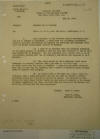
|
22. May 14, 1928.
Secret G-2 Report on Mexican Aid
to Sandino, Major Fred T. Cruse,
Military Attaché, Tegucigalpa.
"Subject: Mexican Aid to
Sandino. ¶ To: The A.A. of S.,
G-2, War Dept., Washington, D.C.
¶ 1. With reference to the
attached report concerning
Mexican aid to Sandino in
Nicaragua, I would make the
following statements, based on
personal observation in Honduras
and Nicaragua and numerous talks
with the Marine Intelligence
Officer in Managua: ¶ (a) I know
of no instance with the possible
exception of one where members
of Sandino’s band who have been
captured or killed have been
identified as Mexicans. The one
exception was a report sent to
me by the marines, stating that
one of Sandino’s sub-chiefs was
supposed to be a Mexican. ¶ (b)
The route stated by which
Mexicans would enter Nicaragua
is entirely feasible until you
come to the last step - - - - -
in other words from the coast to
Sandino. A very few men might
occasionally slip in this way
but anything like a number of
Mexicans going through would be
spotted very promptly. ¶ (c) On
arrival here a few days ago I
had a long conversation with a
young Nicaraguan who was Dr.
Juan B. Sacasa’s private
secretary during the revolution
started by Sacasa. He informed
me that Sacasa had been helped
fairly freely by some source in
Mexican aid so far as officers
and men were concerned. ¶
(Signed) Fred T. Cruse. ¶ Fred
T. Cruse, ¶ Military Attache. ¶
1 encl."
|
|
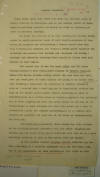
|
23. May 28, 1928.
G-2 Report on Sandino Situation,
Major Fred T. Cruse, Military
Attaché, Costa Rica, p. 1.
"Sandino Situation. ¶ Since
about April 30th there have been
two distinct areas of bandit
activity in Nicaragua - - one on
the western border of Nueva
Segovia, centering opposite San
Marcos de Colon in Honduras, the
other in northern Jinotega. ¶
The first has nothing to do with
Sandino, the trouble being
caused by small, unrelated bands
of pure bandits, composed of
Hondurans, Nicaraguans and
Salvadoreans. A recent report
from Gen. Juan B. Chaves, who
commands the Honduran border
guard opposite the disturbed
area, states that Marines and
airplanes are making a thorough
and effective clean-up. There
should be little more difficulty
in this region. ¶ The second
area is now the upper BOCAY and
CUA River valleys. Sandino’s
main force, under command of
General Giron, is there. With
Marine columns moving toward the
area from the East, West, and
South, most of these bandits are
going to be forced over into
Honduras. I explained the
situation to General Pineda
Honduran general as soon as I
arrived here a week ago, and he
immediately ordered the bulk of
the border patrol, under General
Mondragon, to move to CIFUENTES.
This is a little place in
Honduras, opposite the northeast
tip of Nueva Segovia, and near
the point marked on the map as
LAS TROJAS. There is some
evidence now that this point was
a sort of information center for
Sandino personally, so it is
likely that another, and
possibly the last one of his
lines of communication has been
out. ¶ Gen. Mondragon,
apparently after conferring with
Marines in the vicinity, marched
yesterday with two weeks’
supplies, via Paredes and the
WAQUE River, toward BOCAY. He
will thus be in a good strategic
position to pick up men forced
over the border. ¶ As for
Sandino himself, Froylan Turcios
admitted day before yesterday to
a reliable informant that for
the first time one of his
messengers had been captured, so
that while he knew . . . "
|
|
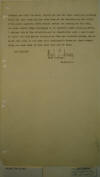
|
24. May 28, 1928.
G-2 Report on Sandino Situation,
Major Fred T. Cruse, Military
Attaché, Tegucigalpa, p. 2.
"
. . . Sandino was still in Nueva
Segovia, he did not know where,
and probably would not hear from
him for some time. In the
meantime, on the PATUCA River,
about apposite where Marine
forces are working on the COCO,
are some lumber camps belonging
to American named Capt. B.C.
Brown. I advised him of the
situation, and he immediately
sent a man to get in touch with
the Marine forces, help them get
reliable guides and son on. He
will also do the same with
Mondragon’s force, so about
everything has been done on this
side that can be done. ¶ May 28,
1928 ¶ Fred T. Cruse ¶ Major,
G.S."
|
|
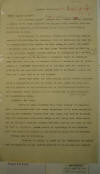
|
25. June 18, 1928.
G-2 Report on Sandino Situation,
Major Fred T. Cruse, Military
Attaché, Tegucigalpa, p. 1.
"Sandino Situation. ¶ Entire
Aspect Changed. ¶ In a previous
report I stated that Sandino had
not received a dollar of the
sums collected for him, and
until recently that was so. He
was demanding contributions of
as little as five dollars
everywhere he went. ¶ The
situation is radically changed
now. During May Turcios received
$11,000 from the Communist Party
in Mexico, but early this month
a messenger came in, and a few
days later Turcios sent on $3000
by a man who calls himself
Gustavo Morales or Machado. He
is a Mexican and is the agent of
“El Machete” a Communist paper
in Mexico. He made the trip and
when he returned brought a
complete set of photographs of
Sandino’s operations at La Luz.
They were for Turcios to publish
in his paper, but were turned
over to me before Turcios saw
them and I sent them on to the
Marines. ¶ Since then money has
been pouring in, and Turcios has
sent several messengers on with
it. I know in most cases who
they are, and all details of the
route- -as far as the Nicaraguan
border, and have reported these
details to the Marines and to
Gen. Pineda, who is co-operating
fully. ¶ Sandino’s New Plan. ¶
There is ample evidence that
after losing his supplies near
Murra, Sandino saw that armed
resistance would soon accomplish
nothing, and informed Turcios
that only money and lots of it,
would keep the situation alive.
That money is now being sent
from Mexico and is actually
reaching Sandino. Reliable
reports are that it will be used
to organize a series of
uprisings I the interior with
the object of preventing the
election being held in October.
¶ Turcios Has No Initiative. ¶
Turcios is purely an agent of
the Communists in Mexico and
particularly of the Sandino
faction of it. He does not
receive . . . "
|
|
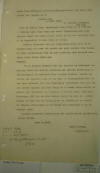
|
26. June 18, 1928.
G-2 Report on Sandino Situation,
Major Fred T. Cruse, Military
Attaché, Tegucigalpa, p. 2.
"
. . . money from different
organizations. Apparently all
funds collected for Sandino go
to ¶ Carlos Leon ¶ P.O. Box #
619, ¶ or Avenida F. I. Madero ¶
Box 215, ¶ both in Mexico City.
Messengers then bring it to
Turcios. I usually know when
these men reach Tegucigalpa, and
when someone takes the money on
, but there is so much activity
that it is impossible to keep
track of it all. ¶ Radical
newspaper men are constantly
being sent on to Sandino. They
all come via Mexico and have
letter from there. No other
credentials will do. This
activity also started suddenly
about three weeks ago. ¶
General. ¶ It is clearly evident
that all parties in Nicaragua
are playing their own selfish
politics, and leaving everything
to the Marines. I am convinced
from Froylan Turcios’ sudden
activity and apparent lack of
any fear of consequences, that
he has been informed that the
Nicaraguan Government will not
ask for action against him. That
being so it seems unreasonable
to expect the Government of
Honduras to do the dirty work
that Nicaragua will not do. Also
Mexico should be able to a great
extent to stop the aid being
given to Sandino. If it cannot
be stopped there, there is no
reason for expecting it to be
stopped here. ¶ Source: -
-Personal observation and
confidential information. Report
No.28. ¶ June 18, 1928. ¶ Fred
T. Cruse, ¶ Major, G.S."
|
|
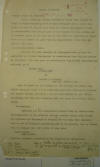
|
27. July 2, 1928.
G-2 Report on Sandino Situation,
Major Fred T. Cruse,
Military Attaché,
Tegucigalpa.
"SANDINO SITUATION. ¶ Sandino
Afraid of Treachery. ¶ About a
week ago Turcios received a
letter from Sandino in which he
begged earnestly that no more
newspaper men or other outsiders
be send to him, and that only
the regular messengers be used
in communicating with him. He
gave as his reason that the
Marines had an enormous price on
his head and he was afraid of
treachery. He added that what he
needed was good fighting men,
BRINGING THEIR GUNS AND PISTOLS
WITH THEM. ¶ Anti-Imperialistic
League. ¶ Attached are some
examples of propaganda sent by
this organization to Froylan
Turcios, who is translating them
for publication in “El Ariel.”
The back page is particularly
vicious. The contributions
collected go to ¶ Carlos Leon, ¶
P.O. Box #619 ¶ or ¶ Avenida
F.Y.Madero ¶ Box 215. Mexico
City. ¶ Both of these are the
address of “El Machete”, an
openly Communist paper, of which
a late issue, obtained from
Turcios, is attached. The marked
article publishes a letter from
Turcios to the Editor,
accounting for some $800
received from the paper for
Sandino during March. ¶
Photographs. ¶ Enclosed are the
photographs brought back by
Machado from Nicaragua. This is
the original set, the Marines
having made copies and returned
the originals to me. They are
the only real pictures made so
far of Sandino’s activities, and
it is probable that no others
will be made, so they are worthy
of some care. ¶ Report No. 29 ¶
July 2, 1928. ¶
Sources:--Personal observation
and confidential information. ¶
Fred T. Cruse."
|
|
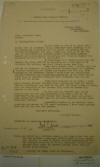
|
28. May 31, 1928.
G-2 Report on A Letter from
Froylan Turcios to Sandino
(English translation), Major
Fred T. Cruse, Military Attaché,
Tegucigalpa.
"TRANSLATION. ¶ A LETTER FROM
FROYLAN TURCIOS. ¶ Revista
Ariel, ¶ Tegucigalpa, ¶ May 31,
1928. ¶ Señor Dr. Carlos Leon, ¶
Mexico. ¶ My Distinguished
Friend: ¶ On the night of the 3d
of April last I handed over to
Macedonio Diaz, a messenger sent
directly to me by Sandino, and
in whom he has the utmost
confidence, $740.62 ($80.82 in
medicines and other things you
told me to get and $660 in cash)
– from the thousand-dollar draft
from MAFUENIC brought me by Lic.
Gustavo Machado, and for which
my receipt was published in No.
17 of “El Libertador”. ¶ In
accordance with instructions
from the General the other
$259.38 is deposited in a bank
here to be available for getting
any other things he may send
for. ¶ There were present when I
handed over the $740.62 to
Macedonio Diaz; Lic. Gustavo
Machado, Agent of Mafuenic;
Esteban Pavletich, (who signed
the receipt for the mail from
Sandino, as the messenger
couldn’t write) – and the
Nicaraguans Mairena Hernandez
and Altamirano, companions of
the other two in their trip to
Sandino’s camp. The said
Macedonio Diaz was the guide for
the group. ¶ Since that date –
the 3d of April – I have heard
nothing further directly from
Sandino, nor from our friend
Gustavo Machado, nor any word of
the mail and other things we
sent, with the exception of two
letters they wrote me before
they arrived at his camp. ¶ By
the time you receive this letter
Machado will be with you,
according to an item I saw in
“El Libertador”. When you have
talked with him, and read the
letter I sent please let
MAFUENIC know of the safe
delivery of the above mentioned
$740.62. ¶ Apparently Sandino is
in Northern Nicaragua and on
account of the great distances I
have heard nothing from him for
the last two months. ¶ Heartiest
greetings, ¶ FROYLAN TURCIOS. ¶
Certified an accurate
translation. ¶ Fred T. Cruse, ¶
Major, G.S. ¶ Note:-- As stated
in a previous report, a few days
after this letter was written a
messenger finally came in from
Sandino and Turcios has been in
fairly regular communication
with him since. In addition to
the sum mentioned Machado also
carried $2000 from “El Machete”,
making about $3000, as stated in
my report. ¶ MAFUENIC is Manos
Fuera de Nicaragua."
|
|
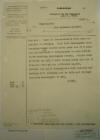
|
29. ca. July 5,
1928. Cable on Sandino's
Lines of Communication, Major
Fred T. Cruse, Military Attaché,
Tegucigalpa, to the Adjutant
General, War Department.
"CABLEGRAM. ¶ Received at the
War Department ¶ July 5, 1928. ¶
9:30A.M. ¶ From Tegucigalpa ¶ To
The Adjutant General. ¶ For G-2.
Line of communication from here
to Sandino is wrecked. Fact that
messengers were carrying money
became known here and of 8 sent
out during the month 7
disappeared or were killed
before reaching Nicaraguan
border. Latter most probably as
only 3 were taking money and one
of them got through and
delivered $3,000. Sandino can
still communicate with Turcios
but Turcios will probably not be
able get through any more
messengers to him. ¶ Cruse. ¶ X
INDICATES CABLE ROUTED FOR
ACTION; [check-mark] FOR
INFORMATION."
|
|
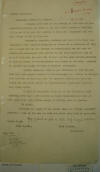
|
30. July 9, 1928.
G-2 Report on Sandino Situation,
Major Fred T. Cruse, Military
Attaché, Tegucigalpa.
"Sandino Situation. ¶ Messenger
service to Turcios. ¶ I finally
have most of the details of this
line of communication. Turcios
has never at any time known
Sandino’s location. All he can
do is wait for Sandino to send
him a messenger and then send
things to him by this man. ¶
Apparently everybody suddenly
got wise to the fact that
messengers were carrying money,
and as stated in my radiogram of
July 2nd of eight men who got
through to Turcios, only one got
back to Sandino. Two messengers
have arrived so far this month.
One came in at 2:00 P.M., July
4th and left at 1:00 A.M. the
next morning. Attached is copy
of letter he carried. Beside the
letter he had only a package of
quinine and copies of some of
Turcios’ propaganda. ¶ Another
messenger came in the afternoon
of July 6th, and left that same
night. Attached is the substance
of a letter he brought. Both men
left on foot and with the
greatest caution, the last one
taking the old trail direct to
Yuscaran, which messengers have
not used since March. ¶ It will
be impossible from now on for
Turcios to send anything more
than a few letters by these
messengers, and most of them
will stand very little chance of
getting back to Sandino. ¶ El
Ariel. ¶ Attached is a copy of
the latest issue of Turcios’
paper. It contains a list of the
men who took the field with
Sandino last year. ¶ Report No.
31 ¶ July 9, 1928. ¶ Fred T.
Cruse, ¶ Major, G.S."
|
|
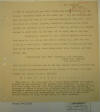
|
31. June 28, 1928.
G-2 Report on Substance of a
Letter from Sandino to Froylan
Turcios in Tegucigalpa, Major
Fred T. Cruse, Military Attaché,
Tegucigalpa.
"El
Chipoton, ¶ June 28th. ¶ I want
to tell, you, so you will
understand, about Sequeria. He
was always a dangerous type and
for some time I had him
prisoner, for fear he would go
over to the Marines. Finally, on
June 16th I had him tried by a
formal Military Court, for
treason. He was found guilty and
sentenced to be shot, but I took
no action, as it seemed unwise
to admit that we had ever had to
shoot one of our men. ¶ However,
the morning of June 27th he
escaped, and as we were sure he
had made up his mind to betray
us, I sent out the alarm. As a
result, that afternoon about
three o’clock he ran into some
of my mounted men about three
miles from Jinotega and they
killed him. ¶ Please tell his
widow Augustina C. de Sequeira,
¶ Porton del Mercado, ¶ San
Salvador. ¶ that he died of
malaria and do not let anyone
beside yourself know what really
happened, because he has plenty
of friends who might resent our
saying he was a traitor. ¶ Note.
This is the substance of a
letter from Sandino to Turcios,
brought by the messenger who
arrived the afternoon of July
6th. Note that under date of
June 28th Sandino describes
something that happened at three
o’clock the afternoon before,
three miles from Jinotega. I
cannot reconcile this with the
fact that all messengers
recently have carried
considerable quantities of
quinine, which Sandino should be
able to get easily if near
Jinotega."
|
|
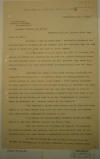
|
32. July 4, 1928.
G-2 Report on Letter from
Froylan Turcios to Sandino
(English translation), Major
Fred T. Cruse, Military Attaché,
Tegucigalpa, p.
1.
"Esteemed General and friend: ¶
Received your two letters dated
June 24th and 25th. ¶ In reply I
want to state that I personally
delivered the instructions to
Trujillo, who has already left
for Salvador, where he will
remain at least two weeks and
then go on to Mexico. ¶ It is a
pleasure to me to inform you
that in Salvador, Guatemala and
Mexico our campaign has reached
the highest pitch, and there is
more personal glory for yourself
and your glorious army every
day. Also, throughout the Latin
world there is devotion, real
love and admiration. ¶ Regarding
the other, I have heard nothing,
absolutely nothing, from
Nicaragua, but I am certain
things are moving, because the
Doctor assures me they are, in a
late letter I have already
mentioned to you. I believe it
wise for you to send directly to
Posoltega and Leon to find our
what has happened and why they
have delayed so long in carrying
out your instructions. However,
I believe they have done as you
directed in the letter you sent
to me for transmission to
Nicaragua, since my messenger is
a trusted friend of the
Doctor’s. ¶ Have received a
letter from Managua, and if they
have done little it is only
because they have not been able
to, for the reasons they have
already communicated directly to
you. ¶ I am giving the bearer,
Emilio Melendez Rivera, 16 pesos
silver to get some clothes and
for the return trip. ¶ With the
arrival of Trujillo and Machado
the campaign in Mexico,
Guatemala and Salvador will be
intensified, as well as in
Colombia, since our good friend
D.R. Castillo leaves shortly for
there. ¶ it will be better for
you to deal directly with our
friends in Nicaragua, as it is
very difficult for me--I cannot
trust [ . . . ]"
|
|
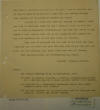
|
33. July 4, 1928.
G-2 Report on Letter from
Froylan Turcios to Sandino
(English translation), Major
Fred T. Cruse, Military Attaché,
Tegucigalpa, p.
2.
". . . the mail, as everybody
tampers with it, and I have no
reliable men by whom to send it,
as the two I sent will not
return, although they carried
out the previous mission all
right. ¶ As soon as I have word
from our friends in Mexico I
will get word to Nicaragua some
way and I think it would be well
for you to send me messengers
frequently, as the word may
arrive at any moment. I have
already sent you on the socks,
and the formula for the acid
quinine, which is the best thing
for malaria. ¶ Take care of
yourself for the sake of the
race and Nicaragua, and may the
great and just God take care of
you and the Army until you can
complete your great work--the
work of Liberty. ¶ Best regards.
Always and enthusiastically
yours, ¶ (Signed) Froylan
Turcios. ¶ Notes. ¶ The Doctor
referred to is Dr. Escolastico
Lara. ¶ Trujillo is Esteban
Trujillo, a Peruvian journalist,
mentioned in a previous report.
He spent several months with
Sandino. ¶ D.R. Castillo is a
Venezuelan newspaper man. He
also spent several months with
Sandino. ¶ The two men referred
to as having been sent to
Nicaragua are Domitilo Ledesma
and Martín Guevara."
|
|
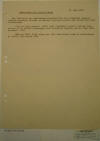
|
34. July 12, 1928.
Memorandum for Colonel Howze.
"The following two radiograms
received from the Commander
Special Service Squadron located
in Central American waters are
quoted for your information: ¶
0110 on July seventh (120) self
confessed bandits turned
themselves in at OCOTAL,
(Nicaragua) and requested
amnesty period they were
unarmed--1230 ¶ 0110 my 0010-
1230 sixty-six (66) additional
bandits surrendered at OCOTAL
July ninth 1605"
|
|
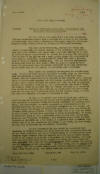
|
35. July 12, 1928.
G-2 Report on Unrest in
Guanacaste, Costa Rica, in
connection with Nicaraguan
Political Situation, Alex A.
Cohen, in absence of Military
Attaché Costa Rica, p. 1.
"For the past several weeks
there have been persistent,
although unconfirmed rumors that
a movement was on foot in the
province of Guanacaste, Costa
Rica, bordering on Nicaragua,
among the Nicaraguan refugees
there, tending toward an
invasion of Nicaraguan
territory. ¶ The Costa Rican
Government, although not making
any public announcement, has
become alarmed at the situation.
The government very well
realizes that should such a
movement actually be on foot it
would be almost impracticable to
prevent its crossing into
Nicaragua. With an army of but
200 men and a small police
force, the government of Costa
Rica is physically incapacitated
to patrol and watch a frontier
most of which is entirely
unpopulated. With the American
intervention in Nicaragua being
far from popular with the
general public in Costa Rica,
the government would experience
differently in calling
additional troops under arms for
the purpose of preventing such a
movement. ¶ This office has
carefully investigated the
alleged movement. It has been
found that no organized
movement, that is, the
enlistment and equipment of
bands is or has been going on in
Costa Rica. Neither arms nor
ammunition can be obtained in
any quantity here. Although
there is considerable sympathy
with the Sandino movement, such
sympathy is no more than a
mental attitude and hardly will
take the form of physical,
material or financial
assistance. In a conversation
with General Volio, the radical
leader in sympathy with the
Sandino movement he is quoted to
have stated in confidence that
although an organization has
been formed here for the purpose
of collecting money for the
Sandino cause, no money had ever
been actually collected or
forwarded to him. ¶ It will be
remembered that several years
ago, during a period of unrest
in Honduras, the charge was
frequently made that bands were
permitted to organize within
Guatemalan territory and
received arms there. The
undersigned personally conducted
an investigation in the frontier
territory and found no
indication whatsoever of the
charge. At the same time, even
though the border was patrolled,
there was nothing to prevent
little groups of three or four
men with arms to go back and
forth as they please. An
identical condition is found in
Guanacaste. No force, no matter
how large or well distributed
could prevent small groups from
crossing into Nicaraguan
territory. Such isolated groups
could probably purchase an old
rifle and a few rounds of
ammunition from individual farm
owners, but as to the organizing
and arming of any force, say
from twenty men up, this
possibility may be entirely
discarded. ¶ In this connection
it also should be remembered
that wherever, in Central
America, one finds three or four
emigrados from one of the other
republics, one has a potential
group of revolutionists whose
favorite topic whenever they get
together in a bar room or other
public place is the laying of
plans for a revolution in their
country. They may have been away
from their mother country for
years, yet they remain the same
patriots: with plans for the
redemption: of their country and
chasing out the usurpers: of the
government. In other words, one
can always hear plotting- it’s
the favorite indoor sport of
this political emigrado element-
they thrive on it. The actually
outbreak, however, seldom
occurs. . . . "
|
|
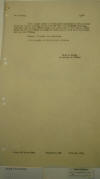
|
36. July 13, 1928.
G-2 Report on Unrest in
Guanacaste, Costa Rica, in
connection with Nicaraguan
Political Situation, Alex A.
Cohen, in absence of Military
Attaché Costa Rica, p. 2.
"G-2 report. ¶ 2,700 ¶ With
a large number of Nicaraguan
emigradoes in Costa Rican
territory at the present, it is
believed that such abstract
planning, probably made in some
public place, has given rise to
the rumors quoted above and that
no actual movement is either now
on foot or contemplated for the
near future. ¶ Source: Personal
investigation. ¶ IN THE ABSENSE
OF THE MILITARY ATTACHE: ¶ Alex
A. Cohen, ¶ in charge of office.
¶ From: M/A Costa Rica ¶ Report
No. 290 ¶ July 13, 1928."
|
|
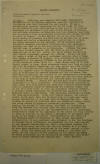
|
37. July 19, 1928.
Secret Paraphrase of Message
from Commander Special Service
Squadron on East Coast of
Nicaragua, p. 1.
"Referring your message
1317-1130: COMSPERONS
accompanied by the Brigade
Commander recently completed an
inspection trip that included
the east coast. It was a
scrutinizing personal inspection
and it was found (?) that as the
result of good organization on
the part of the Brigade
Commander and consistent hard
work of the Brigade of Marines,
the military situation in
Nicaragua has been steadily
improving and is now in a very
satisfactory condition even
though Sandino is still at
large. It was brought out on the
trip that a great amount of
prestige has been lost by
Sandino due to raids on mines
and having antagonized local
population by robbery and harsh
treatment of the natives. It is
believed that Sandino’s prestige
throughout Nicaragua has been
decreasing steadily and that it
is now much greater throughout
Latin America than it actually
is in Nicaragua. Outlaws for
sometime have avoided contact
with the Marines and our one (?)
casualty was on May 18. During
the rainy season the Marines
have arisen vigorously against
the outlaws. During the past six
weeks a total of 538 self
confessed bandits, many of whom
were former followers of
Sandino, have surrendered and
availed themselves of the
amnesty offered by the private
proclamation of the President
dated April 11. Even though only
22 of this number turned in
arms, their surrender shows that
they no longer are able to
subsist themselves and they
prefer the life afforded by the
Marines to that offered by
Sandino. It is believed that the
present force of Marines and
Bluejackets in Nicaragua will be
sufficient to prevent Sandino
and his followers from affecting
appreciably the outcome of the
Presidential elections. Navy and
Marine personnel who can speak
Spanish are being assigned to
duty in connection with the
election under the command of
General McCoy. A school for
Spanish with native Nicaraguan
instructors is being conducted.
Very satisfactory progress is
being made with this school and
Navy will furnish General McCoy
with an excellent corps of
assistants for election duty.
Due to the fact that there is
only one candidate (General
Moncada, a Liberal) whose
nomination has received the
approval of the National Board
of Elections. The political
situation is still far from
satisfactory. As we have before
stated, the Conservative Party
split into two factions both of
which held nominating
conventions at the same time in
Managua (May 20). One faction is
backed by President Diaz and
nominated Cuadro Pasos, the
other headed by Chamorro
nominated Rappaciolli. After
hearing the claims of both
sides, the Board of Elections on
July 7th decided that neither
side has duly established its
rights to be recognized as the
representative of the historical
Conservative Party to the
exclusion of the other and that
neither of them is entitled to
designated a candidate to
represent that party in the
coming election. Not
withstanding the offer of the
National Board of Elections to
give prompt responsive
consideration to any practical
plan advanced by the two
factions to compose their
differences, no agreement has
yet been arrived at and present
indications are that a
compromise between the two
factions seems unlikely and that
an attempt will be made to have
each candidate recognized by the
Board through a petition. Since
the Board has not made known or
published the rules for the
conduct of the election or the
method by means of which
candidates may be recognized on
petition, this situation is
rather awkward and complicated.
While matters . . . "
|
|
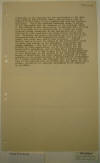
|
38. July 19, 1928.
Secret Paraphrase of Message
from Commander Special Service
Squadron on East Coast of
Nicaragua, p. 2. ".
. . pertaining to the election
and the supervision of the same
come directly under General
McCoy, who naturally acts in
matters of this sort, he had
consultation with the Squadron
Commander. While the Squadron
Commander deems it proper to the
Department that the decision of
the Electoral Board is
undoubtedly correct technically,
he believes that it would have
been wiser and in keeping with
our avowed and often repeated
policy pertaining to the
Nicaraguans and a fair election
to have permitted both
Conservative candidates to run.
Obviously two sets of candidates
could not run as the
representatives of the
Conservative Party, but this is
a detail that could have easily
been arranged. General McCoy’s
desire to heal the breach in the
Conservative Party and have them
combine on one candidate, thus
making the coming election a
fair test of strength between
the two parties is fully
appreciated, but to disqualify
the two Conservative candidates,
each of whom has a considerable
following, even if it may be
said that such disqualification
is only temporary, in the
opinion of the Squadron
Commander savors of sacrificing
the board general principle of a
free election to the
considerations of administrative
convenience. The Squadron
Commander has concluded that
rules for the conduct of the
election will be printed soon
and issued and will contain
provisions for enabling
candidates to be nominated by
petition."
|
|
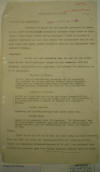
|
39. July 18, 1928.
G-2 Report on Anti-Imperialist
League, Major Fred T. Cruse,
Military Attaché, Tegucigalpa, p. 1.
"Attached are copies of the
magazine published in Mexico by
the above organizations
subsidiary MAFUENIC (Manos Fuera
de Nicaragua.) which means
“Hands off in Nicaragua.” There
is nothing of special importance
in this issue except the
announcement that in the next
issue will begin Gustavo
Machado’s story of his
experiences with Sandino’s
forces. ¶ Personnel. ¶ So far as
I can ascertain here the men who
are active heads of the
Anti-Imperialist League are all
connected with the Communist
organization that publishes “El
Machete. “The following may be
of importance. ¶ Dr. Pedro J.
Zepeda. ¶ He is a man of
considerable standing and is
apparently the lobbyist or
liaison officer between these
organizations and the
Government. His great friend was
General Alvares, recently
dismissed as Chief of the
Presidential Staff. ¶ Esteban
Pavletich. ¶ So far as I can
find out he is the direct
connection between the Communist
Party of Russia and the
Anti-Imperialist League. He
spent a couple of months with
Sandino’s forces. ¶ Jacobo
Hurwitz. ¶ Secretary of
MAFUENIC. Nothing else known
about him. ¶ Carlos Leon. ¶
Seems to be connected with “El
Machete,” “El Libertador” and
all the various Communist and
anti-American organizations in
Mexico. Turcios gets his
instructions and make his
reports to him. ¶ FUNDS. ¶ There
is no way for me to tell how
much money has been received
from all over the world for
Sandino, MAFUENIC, the
Anti-Imperialist League and
connected organizations, but of
it all I am convinced that
Sandino has received less than
twenty thousand dollars since he
first . . . "
|
|
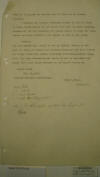
|
40. July 18, 1928.
G-2 Report on Anti-Imperialist
League, Major Fred T. Cruse,
Military Attaché, Tegucigalpa, p. 2.
".
. . took the field, and the
greater part of this was in
Medical supplies. ¶ I believe
the Mexican Government should be
able to break up these
organizations on the ground that
they are pure swindling schemes.
All the men concerned are making
plenty of money for themselves
and using Sandino’s name simply
as bait to get funds. ¶ General.
¶ The Anti-Imperialist League so
far in Central America is the
same old group of Radical and
grafting newspaper men like
Turcios and Zuñiga Huete. They
spread propaganda constantly,
collect money which they keep
themselves, and really do not do
one-tenth the damage that their
fellow-members in the United
States do."
|
|
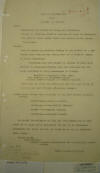
|
41. July 18, 1928.
G-2 Report on Line of
Communication from Sandino to
Turcios, Major Fred T. Cruse,
Military Attaché, Tegucigalpa.
"Route. ¶ Tegucigalpa to
Talanga--50 miles--by
automobile. ¶ Talanga to
Jacaleapa, Danlí or Escuapa--two
days on horseback. ¶ From each
of these points there were
several trails across the
border. ¶ System. ¶ There is
never any previous warning of
the arrival of a messenger from
Sandino. They simply show up at
Turcios’ office or other
rendezvous. ¶ Returning, they
were picked up outside of town
after dark by an automobile.
Turcios paid the following men
for being available to carry
messengers to Talanga: ¶
Benditti--Proprietor Hotel Roma.
¶ Lala Moncada---A well-known
sport. ¶ Dr. José
Durón---Surgeon at General
Hospital ¶ There were at least
two others, all men who could
leave in a car at any house
without attracting comment. ¶
Points where horses were
available at any hour without
previous notice. ¶
Cantarranas--Rafael Salazar. ¶
Jacaleapa----Gen. Teofilo
Cárcamo. ¶ Danlí--------Manuel
Guillen. ¶ Cifuentes----Leopoldo
Gamero. ¶ As stated in radiogram
of July 2nd this system led to
the death of at least seven
messengers and had to be
abandoned. Messengers now leave
on foot and there is no way to
ascertain their route."
|
|
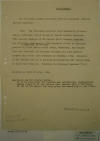
|
42. ca. July 20,
1928. Confidential Report
on Information received from
General Manager of the United
Fruit Company, from the
Commander Special Service
Squadron.
"0020 The following received
from Commanding Officer, U.S.S.
CLEVELAND, which is not at
Puerto Cortes, Honduras: “The
General Manager of the United
Fruit Company imparted the
following information: ‘The
Minister of War of Honduras
arrived at (four letter word), X
Believed to be TELA, today,
Wednesday, and states that the
President of Honduras informed
him that Sandino crossed the
border into Honduras on Tuesday,
17th, Minister of War states
that he is sending approximately
200 troops from La Ceiba and
Trujillo, Honduras to intercept
Sandino. ‘ “1115 ¶ Received at
2228 20 July, 1928. ¶ Memorandum
in for Colonel Howze. Up to 15
July, 1928- 217 bandits had
surrendered. Headquarters Marine
Corps is of the opinion that
Sandino with a following of 100
to 150 men, is the only group
now operating in the field."
|
|
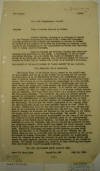
|
43. July 20, 1928.
G-2 Report on Trip of Sandino
Follower to Mexico, Alex A.
Cohen, in absence of Military
Attaché, Costa Rica, p. 1.
"Gustavo Machado, claiming to be
delegate to Sandino of the
“Central Committee of a United
Front- Hands off Nicaragua”
recently passed through Salvador
and Guatemala on his way to
Mexico. He claimed as the
purpose of his trip the
necessity of rendering a full
report to the headquarters of
the organization in Mexico City
regarding what is taking place
in Nicaragua. ¶ Both in Salvador
and Guatemala Machado made
extensive anti-American
statements in the press. A
translation of one of these
statements follows. As most
likely the object of Machado’s
trip to Mexico is to obtain aid
for Sandino, this office has
cabled the Military Attache in
Mexico City to inform this
office as to Machado’s
movements. ¶ TRANSLATION OF
ARTICLE BY MACHADO IN “DIARIO
LATINO” OF SAN SALVADOR. ¶ “THE
FEROCIOUS WAR OF AGGRESSION.” ¶
The Marine Corps of the United
States, formed by the social
scum of that country does not go
to any trouble in carrying out
the mission conferred upon it by
the Department of State; the
disarmament and capture of
General Sandino and preparation
for the coming presidential
elections. The marines do not do
anything but assassinate in a
cold blooded, cowardly and
systematic manner the
defenseless inhabitants; set
fire to their abodes and crops;
kill their cattle; rob their
fruit and, finally, flee
terrorized before the Sandino
forces. It is Sandino who
persecutes the invaders and when
some fight takes place it is
because Sandino catches them by
surprise. They keep their good
mounts at the discreet distance
from the Nicaraguan patriots.
This ferocious war, this war
without quarter against the
defenseless population of a
country has no antecedent in
history. The cruelest wars of
imperialistic nations always has
as their primordial end, as
their principal object, the
destruction of the army of the
adversary. In Nicaragua the
entire population of the regions
where the Liberating Army passes
has been declared “beyond the
law” (FUERA DE LA LEY). During
holy week and the week
thereafter more than seventy
hamlets in the department of
Nueva Segovia were set fire to.
Why? Because General Sandino had
abandoned the Segovias by his
expedition to the Atlantic
Coast, which the public already
knows about. The proof? I have
enormous lists of the
inhabitants assassinated and the
names of the places. The
Honduran frontier furnishes an
eloquent proof of the
“civilizating” procedure of the
United States bankers. In Danli
and Paraíso (Honduras) hundreds
of women and children, many of
them wounded by explosive
bullets are dying from hunger.
Their abodes were burned and
their husbands either killed by
machine gun fire or else are in
the ranks of the liberating
army. General R. Mondragon,
commander of the Honduran
garrison which guards the
frontier is an assassin in the
pay of the Yankees; the .45
pistol which he uses is a
present from the commanding
officer of the marine detachment
at Jalapa, Nicaragua. This
wretch captures and assassinates
those who endeavor to cross the
frontier to join the Sandino
forces and abuse the poor
fugitive families which seek
hospitality in the sister
republic. The ladies of
Tegucigalpa, moved by so much
suffering have organized
assistance for these Nicaraguan
families. ¶ THE ANTI IMPERIALIST
LATIN AMERICAN ARMY. . . ."
|
|
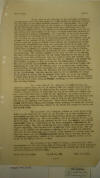
|
44. July 20, 1928.
G-2 Report on Trip of Sandino
Follower to Mexico, Alex A.
Cohen, in absence of Military
Attaché, Costa Rica, p. 2.
". . . In the army of the
defender of the national
sovereignty of Nicaragua there
does not exist the least vestige
of frontier grudges. The
majority of the Latin American
nations are represented. The
ideal of unification and
fraternity of our people is
realized and practiced in the
Nicaraguan camps. The Sandino
boys know definitely that the
Nicaraguan problem can not be
solved in an isolated manner,
that Nicaragua defends the
sovereignty of all Latin
American countries violated or
threatened by American
capitalism. The situation of the
anti imperialist struggle is
perfectly known and discussed
there. General Sandino and his
army are not a group of
Quijotes; optimism, unbreakable
faith in triumph is the product
of the experience of more than a
year of strife during which the
group of thirty which refused
the ratification of the
treasonable Stimson-Moncada pact
has converted itself in an army
well equipped with all classes
of arms, good mounts and riding
equipment and sufficient
ammunition to sustain the
struggle till the final triumph.
All the equipment, absolutely
everything has been captured
from the invading troops. The
Sandino uniform is the same as
that of the marines, the only
difference being the read and
black ornament of the collar and
the hat. And even this
difference does not exist
because the “machos” (and
insulting name for foreigners)
when they try to surprise some
hamlet use the Sandino insignia
so they will not be discovered
from a distance. The most
powerful imperialistic nation in
the world has been beaten and
humiliated in more than 25
combats, arms and ammunitions,
provisions, medical kits,
photographic apparatus and
various flags having been
captured from them. The Stars
and Stripes have been abandoned
various times on the
battlefield. And the marines
seat to the battlefield are
still being fooled by being told
in Managua that “they are to go
and disarm a badly armed groups
of bandits”. We are fighting in
Nicaragua to triumph and it has
been shown that, militarily
speaking, we are invincible
before the invading forces. ¶ It
is the duty of the laborers of
Latin America, in whatever
country they may be, to comply
with the urgent duty of
contributing their contingent in
confronting the common enemy.
One can be a Sandino soldier
outside of Nicaragua and can be
so even more useful and more
efficient than with a rifle in
the Segovias. In these moments
of confusion and danger for
Central America there are three
men in Nicaragua who are a
symbol and who mark the path of
duty to the inhabitants of
Guatemala, El Salvador and
Honduras. These three fighters
are Generals Manuel Maria Giron
Ruano, Guatemalan; Simon
Montoya, Honduran and Colonel
Jose Leon Diaz, Salvadorian,
chiefs of the first and second
companies and the Somoto Zone. ¶
The immediate and principal
problem of these three countries
is not found on the banks of the
Motagua nor in the exaltation of
nationalism against the Central
American Union; these are
maneuvers of imperialistic
interests. The real problem,
vital to Central America, is in
Nicaragua. We all should
endeavor to see that the popular
and genuine enthusiasm which is
manifested in the three
countries materializes in
effective help. The army
defending the sovereignty of
Nicaragua does not require
anything. The marines have
everything which they need. But
the army had to relieve the
defenseless victims, has to
assist the families interned in
the mountains, has to nurse
those wounded by machine guns
and airplane bombs and all
should contribute their aim to
prevent that the defenseless
population, victim of the
systematic ferocity of the
marine corps of the United
States, perish. ¶ The urgency of
my return to Mexico, proceeding
from the headquarters of the
Liberating Army of Nicaragua
prevents me from complying with
the express recommendation of
General A.O. Sandino to visit
the important newspapers of this
city. . . . "
|
|
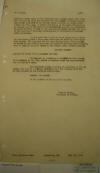
|
45. July 20, 1928.
G-2 Report on Trip of Sandino
Follower to Mexico, Alex A.
Cohen, in absence of Military
Attaché, Costa Rica, p. 3.
". . . General Sandino knows of
the energetic and valiant manner
with which the Salvadorian press
has defended the sovereignty of
Lain America, militarily
concreted in the bloody strife
against the Yankee filibusters
in Nicaragua. I desire
therefore, in the name of
General A. C. Sandino and in the
name of his illustrious general
representative in Latin America,
present to the Salvadorian
people through the press of the
capital, fraternal greeting and
an expression of absolutely
faith in triumph. ¶ At the same
time I wish to state along
general lines the impression
which I bring from Nicaragua and
clear up some important points.
The complete and detailed report
which I will present in Mexico
to the Central Committee of
United Front HANDS OFF
NICARAGUA, will be sent in the
near future to the entire press
of the Continent. ¶ GUSTAVO
MACHADO” ¶ COMMENT BY OFFICE OF
THE MILITARY ATTACHE: ¶ No thing
new or startling is revealed by
this report. It is cloaked by
the same spirit of bravado which
has characterized all of
Sandino’s acts. ¶ One important
point, however, is contained in
the article, and that is a
virtual admission that the
Honduras frontier is well
guarded by the Honduran
authorities."
|
|
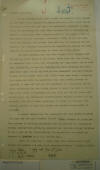
|
46. July 23, 1928.
G-2 Report Sandino Situation,
Major Fred T. Cruse, Military
Attaché, Tegucigalpa, p. 1. "On
the morning of the 18th a cable
was received from Managua to the
effect that Sandino was moving
down the PATUCA River toward
CARATASCA LAGOON with the object
of receiving a shipment of arms.
AS we had previously had word
from Guatemala that a schooner
was trying to bring some from
Progreso, Mexico to that point,
I went to GEN. Pineda and the
Government organized a force of
200 men from CEIBA and TRUJILLO
and started them off with two
launches for the Lagoon. I also
informed Capt. Brown, who
immediately started off from
Castilla on his own initiative
to watch the PATUCA River. ¶ The
next morning word came from
Managua that Sandino with 300
men was eight miles up the
POTECA River from the COCO
River, in Honduras. I had a talk
that afternoon with Gen. Pineda
and he went over immediately to
see the President. The next
morning-(the 20th)- Gen. Pineda
sent for me and told me the
Government was very anxious to
know if the report about the
POTECA River were true. I
suggested the planes, and this
was apparently what they wanted,
because he approved at once and
told me the President had
authorized him to grant
permission for the Marine planes
to scout the area as far as the
PATUCA River if necessary. He
also said that if the force were
really there the
Government-(SECRET)- would
declare martial law and secretly
give the Marines permission to
cross the frontier and operate
against it with both planes and
ground troops.-( End of SECRET?)
¶ I cabled immediately the
permission for the planes to
scout the area and the next
morning Dr. Dana H. Munro
arrived by plane for the purpose
of securing permission for the
Marines to attack. This having
already been given, The Minister
and Dr. Munro simply verified it
by a call on the President, and
the permission was cabled to
Managua at 4:00 P.M. on the
21st. ¶ About the same hour a
cable came from Managua that
Major Rowell had scouted the
area that morning, had found a
regular little . . .
|
|
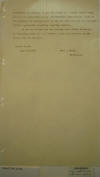
|
47. July 23, 1928.
G-2 Report Sandino Situation,
Major Fred T. Cruse, Military
Attaché, Tegucigalpa, p. 2. ".
. . cantonment established in
the buildings of a former lumber
camp, that he had been fired on
by anti-aircraft guns-always a
sign of the presence of
Sandino--that he had not been
hit and had returned without
apparently observing anything
unusual. ¶ So far as we know now
the Marines will attack
to-morrow or Wednesday, using
all the Corsair planes they
have. No ground troops will be
employed."
|
|
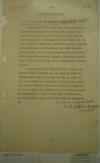
|
48. July 19, 1928.
Strictly Confidential Report on
Political Conditions in Honduras
on the North Coast, Vice Consul
Winfield Scott, Tegucigalpa.
"STRICTLY CONFIDENTIAL ¶
POLITICAL CONDITIONS ¶ Political
conditions throughout the
district continued calm
throughout the three month
period under consideration,
although the report received
from the American Minister,
Tegicigalpa, to the effect that
Sandino intended to enter the
Mosquitia Territory, created
some concern to the officials of
the local American Fruit
Company, and to the
representatives of the Honduran
Timber Corporation, engaged in
lumbering activities in the
region through which Sandino
would logically pass. ¶ In
cooperation with Captain Byron
C. Brown, who departed Puerto
Castilla for the scene of
Sandino’s alleged entry into the
country on July 18, with the
view of ascertaining personally
or through his reliable agents,
whether flight from Nicaragua or
pillage in this district was
contemplated, the Vice Consulate
is endeavoring to keep with the
situation, and to cooperate
fully with major Cruse at
Tegucigalpa."
|
|
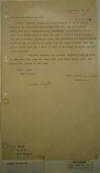
|
49. July 24, 1928.
G-2 Report Political Leaders:
Toribio Tijerino, Major Fred T.
Cruse, Military Attaché,
Tegucigalpa.
"3700.b.--POLITICAL LEADERS. ¶
TORIBIO TIJERINO arrived here
from Salvador at 11:30 P.M. the
night of the 22nd. He is
associating here with Froylan
Turcios, Pablo Leal and a
Venezuelan named H.K. Farrer The
latter came to my notice several
weeks ago when he went to the
bank carrying ten 1000-dollar
bills. The banks were suspicious
and refused either to change one
of them or to accept them for
deposit. Farrer then went to the
North Coast and I heard no more
of him until he showed up here a
few days ago. ¶ Tijerino
informed the Minister yesterday
that he would be here for a few
days and would then leave from
Puerto Cortes for either New
Orleans or New York. ¶ Report
No.36. ¶ July 24, 1928. ¶ Fred
T. Cruse, ¶ Major, G.S."
|
|
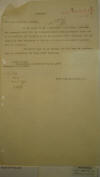
|
50.
September 10, 1928. G-2
Report on Political Leaders: H.
K. Farrer, oil-operator from
Venezuela, Major Fred T. Cruse,
Military Attaché, Tegucigalpa.
"Honduras. ¶ 3700--b. Political
Leaders. ¶ In my report No.36 I
mentioned a man named H.KFarrer,
who appeared here with ten
thousand-dollar bills. Mr.
Farrer turns out to be entirely
all right. He is an oil-operator
from Venezuela and the money had
been intrusted to him by a Mr.
Todd, a well-known engineer here
in Honduras. ¶ Mr. Farrer says
he is looking for oil here in
Honduras. This is camouflage for
some other activity. ¶ Report
No.51. ¶
Tegucigalpa--Honduras--Sept. 10,
1928 ¶ Source-Mr. J.H. Wilson. ¶
Fred T. Cruse, Major, G.S."
|
|
|
|
All the original documents populating these
twelve "FAT FILE" pages are housed in the
United States National Archives in College Park,
MD, in Record Group
165, Entry 77, Box 2653.
|
|
top of page |
|
|

